Cloonlara
Houses within 10km of this house
Displaying 46 houses.
Houses within 10km of Cloonlara
Displaying 46 houses.
| House name | Description | |
|---|---|---|
| Caherdean House | Charles Daly was leasing Caherdean House from Henry Herbert at the time of Griffith’s Valuation, when it was valued at £11 10s. Bary suggests that the Lawlors may have had connections with Caherdean House around 1800 but later in the 19th century the Herberts were the landlords. The house is still extant and part of a large farm. . |

|
| Dromadeesirt Cottage | Catherine Thompson was leasing a property valued at £5 from the Earl of Kenmare’s estate at the time of Griffith’s valuation. Bary states that this family may have been agents for Lord Kenmare and that local tradition suggests Mr. Thompson was killed by being gored by his bull. The property was occupied until the late twentieth century and farm buildings are still extant at the site. | |
| Knocknamucklagh House | Charles Daly was leasing this property from the Kenmare estate at the time of Griffith’s Valuation, when it was valued at £5 10s. Bary indicates that this is a very old property, possibly built by the Fitzgeralds in the early 18th century when they were Kenmare’s tenants here. By the middle of the 19th century the Daly family were occupying the property which is still extant. | |
| Knockaneacoolteen House | William Curtayne was leasing this house from Lord Kenmare’s estate at the time of Griffith’s Valuation, when it was valued at £4 10s and stood on over 300 acres. Bary indicates that the house, possibly built in the 18th century, is still extant. | |
| Molahiffe House | Eliza Griffin was the lessor of this property at the time of Griffith's Valuation, when it was valued at almost £6 and vacant. In 1837 Lewis mentions "Boucheens" as the residence of Montague Griffin. Bary states that this is a very old house and is widely believed to be one of the earliest homes of the Browne family, later Lords Kenmare. It is still extant and occupied. |
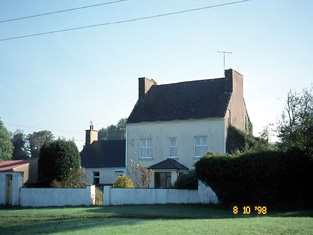
|
| Corbally House (Magunihy) | The Kenmare estate was the lessor of Corbally House at the time of Griffith's Valuation, when it was valued at £11 5s. Bary states that this farm was originally held by the O'Connor, probably of nearby Fieries Castle. Later a Fr. Dunne built Corbally House as a presbytery near the old Catholic Church. The property is still extant and occupied. | |
| Inchinveema | Christopher Gallway was leasing this property to Daniel Sullivan at the time of Griffith's Valuation, when it was valued at £6. Buildings are still extant at the site. | |
| Knocknaman | Henry Denny was leasing a property valued at £9 to William Thompson at the time of Griffith’s Valuation. An uunamed house, surrounded by trees, is marked on the 1st edition OS map. There is no house at this site now. | |
| Ballyhar House | In 1786 Wilson refers to Ballyhar, the residence of Mr. Eager. John Leahy was in possession of this property at the time of Griffith's Valuation when it was valued at £17. Bary states that this house was originally built by the Eager family but later sold to the Leahys. It is now a ruin. | |
| Arabela House | Rev. Arthur Rowan was leasing this property to Hastings Peate at the time of Griffith's Valuation, when it was valued at £20 15s. Lewis records it as the seat of Francis Peet in 1837. The Ordnance Survey Name Books mention that it was the residence of Francis Peet, "of old appearance, built about a century ago". In 1814 Leet notes it as the seat of John Bolton. In 1786 Wilson refers to Arabella as a seat of Mr. Blennerhassett. Bary states that the house was built in the eighteenth century by the Blennerhassetts but that it was lived in by the Rowan family until the mid-nineteenth century. The Peate family occupied it from then until the 1970s. It is still extant. |
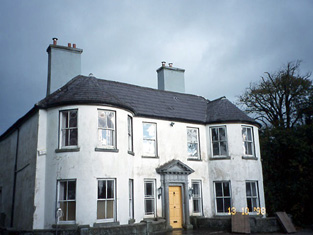
|
| Rathanny House | Elizabeth Rowan was leasing a property to Patrick Holohan at the time of Griffith's Valuation, when it was valued at almost £3. Lewis refers to Rathanny as the residence of Mrs. Rowan in 1837. In the 1830s the Ordnance Survey Name Books noted the house, built c.1730, as the residence of Mrs. Rowan In 1786 Wilson mentions Ratanny as the seat of Mr. Rowan. Bary states that the house was built by the Rowan family in the eighteenth century and lived in by them for much of the early nineteenth century. It was sold in the early twentieth century and is still extant and occupied. |
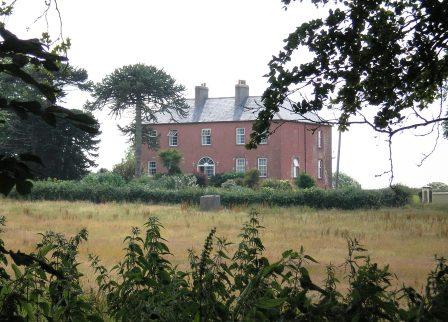
|
| Shanvally | Thomas Blennerhassett was leasing this property to Robert Conway Hurley at the time of Griffith's Valuation, when it was valued at £20. n the 1830s the Ordnance Survey Name Books describe it as the seat of Thomas Blennerhassett, who had built it in 1835. In 1786 Wilson had noted a seat of the Blennerhasset family close to the Rowan house, Ratanny. Bary states that Shanvally was built by the Blennerhassetts as a hunting lodge, possibly in the late eighteenth or early nineteenth century. It is still extant and occupied. | |
| Kilquane | Charles Blennerhassett was leasing this property to Thomas Rooney at the time of Griffith's Valuation, when it was valued at £3, on a farm of 130 acres. This may be the property to which Wilson refers as the seat of William Blennerhasset in 1786 which he names Elm-Grove. A substantial farm is extant at the site. | |
| Knockavinnane Cottage | James Hussey was leasing this property to Alexander Mason at the time of Griffith's Valuation, when it was valued at £15 15s. A portion of the original building is still extant. | |
| Magh House or Edenburn | Colthurst Bateman was leasing a property to Edward F. Day at the time of Griffith's Valuation, when it was valued at £28 15s. On the 1st edition Ordnance Survey map it is labelled as Magh House but on the 1895 edition it is called Edenburn House. Lewis records it as the seat of W. Seely in 1837.The Ordnance Survey Name Books of the 1839s noted that this was the residence of the Sealy family and had been preceded by Rockfield House, the ruins of which were still discernable. Magh is described as "handsomely built of square form, three stories high and cost £2000". Later in the nineteenth century it was occupied by Edward Fitzgerald Day and then by Samuel Murray Hussey, agent to the Kenmare and other estates. In 1906 it was owned by John Hussey and valued at £24. It was used in the later twentieth century by the Southern Health Board as a hospital/nursing home and is still extant. | |
| Maglass House | William Ledmond was leasing Maglass House to Daniel Hilliard at the time of Griffith's Valuation when it was valued at £11 15s. Lewis records Maglass as the seat of W. Ledmond in 1837. The Ordnance Survey Name Books record it as the residence of Daniel Hilliard but originally built by the Ledmond family. Bary, however, states that it was possibly built ty the Babington family who lived there in the eighteenth century. In 1786 Wilson refers to "Maglass" as the seat of Wiliam Sealy. It was later occupied by the Ledmonds who later sold it to the Roche family. Redmond Roche is recorded as residing there in the 1870s. In 1906 it was owned by the representatives of Redmond Roche and valued at £18 5s. It is now derelict and ruinous. |
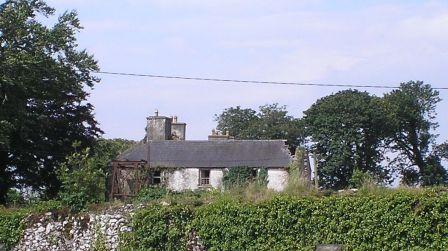
|
| Ballycarty House | At the time of Griffith's Valuation, Charles Blennerhassett was leasing this property to Rev. Edward Nash, when it was valued at £19 5s. Bary states that it was occupied by the Nash family from the late eighteenth century and that it was destroyed in 1922. In 1786 Wilson notes the existence of the ruins of Ballycarty Castle, the property of Mr. Nash. | |
| Ballyseedy Castle | Ballyseedy was a seat of the Blennerhassett family for many generations. Charles Blennerhassett was occupying it at the time of Griffith's Valuation when it was valued at £60. Lewis recorded that Sir Edward Denny was living there in 1837 but that it was a seat of the Blennerhassett family. In 1906 it was owned by Arthur Blennerhassett and valued at £65. The National Inventory of Architectural Heritage (Buildings of Ireland) report states that the house was built c.1760 but renovated and extended at least twice in the nineteenth century. The Irish Tourist Association survey in 1942 reported that the owner then was Miss Hilda Blennerhassett. It remained in the ownership of the Blennerhassett family until later in the twentieth century when it was sold and became Ballyseedy Castle Hotel. [www.ballyseedecastle.com]. |

|
| Camp Lodge | At the time of Griffith's Valuation, Richard Chute was leasing this property to George Hewson, when it was valued at £5 10s and part of a farm of 350 acres. In the 1830s, the Ordnance Survey Name Books describe it as "a small cottage, one story high, the residence of John Hussey". It was offered for sale in the Land Judges' Court in 1883 when it was described as a "comfortable dwelling house, suitable for a gentleman's family". Bary indicates that it had been the home of the Twiss family earlier in the nineteenth century. It is still extant. | |
| Mullaghmarky House | Richard Chute was leasing this property to John Sealy at the time of Griffith's Valuation, when it was valued at £10 10s. In the 1830s, the Ordnance Survey Name Books describe it as " a large house, two stories high, with offices, plantation and ornamental garden, the residence of Eusebius Sealy". Bary states that the Sealys had occupied it since the early part of the nineteenth century. It is still extant though not occupied. | |
| Meanus House | Sir David Roche was leasing the property at Meanus to Michael Neligan at the time of Griffith's Valuation, when it was valued at £9 10s. In the 1830s, the Ordnance Survey Field Name Books describe it as "a large house, two stories high with offices attached at present occupied by a farmer". In 1786 Wilson had noted Menus as the seat of Dr. Drew. Bary states that it has been in the Neligan family for many generations and is still extant. | |
| Riverville (Currans) | Charles Blennerhassett held this property in fee at the time of Griffith's Valuation, when it was valued at £9 15s. Lewis records Riverville as the seat of Richard Marshall in 1837. The Ordnance Survey Field Name Books record Riverville as the residence of Richard Marshall c.1840, describing it as "a thatched house of oblong shape". Bary states that the house was a seat of the Marshell family and believed to have been built by them in the eighteenth century. They remained there until the 1840s. Later in the nineteenth century it was associated with the Spring family It is still extant and occupied. | |
| Sandville House | Robert A. Thompson was leasing this property from the Herbert estate at the time of Griffith's Valuation, when it was valued at £11 5s. Bary notes that it had been frequently occupied by agents to the Herbert estate through the nineteenth century. It is believed to have been built by them in the late seventeenth century. The house is still extant and occupied. | |
| Clashganniv House | John Powell was leasing this property from the Herbert estate at the time of Griffithf's Valuation, when it was valued at £10. Let also notes it as his residence in 1814 though he refers to it as Sandville. Bary states that the Powells continued in residence until the early twentieth century. Clashganniv is still extant and occupied. |

|
| Dicksgrove | Richard Meredith was the owner of this property at the time of Griffith's Valuation, when it was valued at £30 15s. In 1786 Wilson notes Dick's Grove as the seat of Mr. Meredith. Both Leet in 1814, and Lewis, in 1837, refer to it as the seat of the Meredith family. In 1906 it was still owned by the Merediths and valued at £31 5s. Bary writes that this land, granted to the Herberts in the seventeenth century, passed to the Merediths through marriage some time later. The house was built sometime in the 1730s and remained in the Meredith family for 200 years, though Lyons notes that it was offered for sale but later withdrawn in 1855. The sale notice includes a lithograph of the house The estate was sold to the tenants in the 1930s. Dicksgrove was completely demolished but some of the stable buildings and gate lodges remain. |
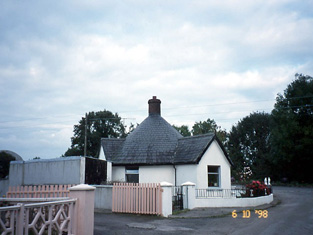
|
| Kilcow House | Robert A. Thompson was leasing Kilcow House from the Herbert estate at the time of Griffith's Valuation, when it was valued at £17 10s. Bary notes that the Herbert family lived here for a time in the eighteenth century before moving to Muckross. The house is still extant and occupied. | |
| Annamore House | Maunsell Andrews was leasing this property to Margaret Roche at the time of Griffith's Valuation, when it was valued at £5 5s, on a holding of 170 acres. Barry quotes O'Donovan, who claims the house was built by the Meredith family in the early eighteenth century. It may also have been associated with Lord Northcote's estate. The Roche family occupied the property since the 1840s. | |
| Killeentierna Glebe | Rev. Thomas Herbert owned the Glebe house at Killeentierna at the time of Griffith's Valuation, when it was valued at £18. Bary states that the house was built by Rev. Herbert in 1839 and was later occupied by Arthur Herbert, a land agent, who was assassinated nearby in the 1880s. The house was later used as a Church of Ireland rectory and later still as a presbytery by the local Catholic parish but has since been demolished. | |
| Parkmore House | Rev. C.Moynahan was leasing this property to Arthur Sealy at the time of Griffith's Valuation, when it was valued at £19 5s. Bary quotes O'Donovan who said it was a set of the Meredith family in the 1830s though she also mentions that it was said to have been built by a Fr. Minahan. It was occupied by members of the Meredith family and later by their descendents and is still extant. Richard Meredith was leasing a second property in this townland to Rev. C. Moynahan which was valued at £5 5s. | |
| Anna | Sir William Godfrey was leasing this property to Cornelius Murphy at the time of Griffith's Valuation when it was valued at £10 5s. Lewis records it as the residence of Reverend O'Connor, PP, in 1837. In 1814 Leet mentions Annagh as the seat of Giles Rae. Bary writes that it was built by the Godfreys in the eighteenth century and was lived in by various members of that family until the early nineteenth century when it was occupied by tenants. It was tragically burnt to the ground in the late twentieth century. Sir William was leasing a second property in this townland to Willam R. Burke, valued at £8 10s. | |
| Laharan House | Sir William Godfrey was leasing this property to James O'Neill at the time of Griffith's Valuation, when it was valued at £7 5s, and part of a holding of 170 acres. It was recorded as the seat of F. Walker by Lewis in 1837 and Leet in 1814 as the seat of Francis Walker. Bary states that it was built by Francis Walker in 1808. The house passed to the Cronin family in the 1880s. It is stil extant and occupied. | |
| Cloonalassan House | Lord Monteagle was leasing this property to John Giles at the time of Griffith's Valuation, when it was valued at £8 5s, on a demesne of 123 acres, some of which extended into Ballycrispin townland. Lewis mentions, in 1837, that Ballycrispin was formerly the residence of the Spring-Rice ancestors. It is not shown on the later 25-inch Ordnance Survey map of the 1890s. | |
| Meanus House (Kiltallagh) | Lady Anne Headley's estate was leasing this property to Charlotte Walker at the time of Griffith's Valuation, when it was valued at £9 15s. Bary writes that it was leased by the Winn estate in the early part of the nineteenth century to the Walkers and later to the Spring family. It is still extant and was renovated in the twentieth century. |
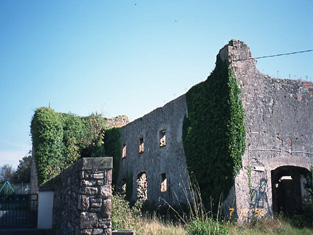
|
| Kiltallagh Glebe | Rev. Brownrigg (or possibly Browning) Drew was in possession of Kiltallagh Glebe at the time of Griffith's Valuation, when it was valued at £17. Lewis records it as the seat of Rev.J. Murphy in 1837. In 1786 Wilson refers to "Menus"as the house of Dr. Drew but he also refers to a residence of Rev. Dr. Day, near Kiltalla church. Bary mentions that it was renovated by Rev. Murphy earlier in the nineteenth century. It was also associated with the Day and Godfrey families. In 1920 it was sold to the Boyle family by the Representative Church Body and is still extant and occupied. | |
| Ballinvariscal House or Mount Prospect | William Massey was leasing this property from TCD Estates at the time of Griffith's Valuation, when it was valued at £5 15s and part of a holding of over 400 acres. In 1814 it was the residence of Roger Lombard. Bary indicates that the house had several different owners in the nineteenth century when it was known as Mount Prospect. It was sold around 1900 and is still extant and occupied. | |
| Woodville (Nohaval) | Richard Norris was leasing this property to Rev. John Fitzgerald Day at the time of Griffith's Valuation, when it was valued at £27. Lewis mentions Nohaval House, as the seat of Rev, Fitzgerald, which seems to be the same property. Bary quotes O'Donovan who indicated that this house belonged to the Norris family. She indicates that the house later passed to Fitzgerald-Lombards and Hicksons. It was sold in the early twentieth century and is still extant and occupied. | |
| Ballyegan | At the time of Griffith's Valuation, Richard Norris was leasing this property to John Millward (senior), when it was valued at £6. In 1814 Leet noted John Hartnett as resident at Ballyegan. Bary indicates that the Millwards occupied this property until well into the twentieth century though they moved to a different house. The original house was demolished to make way for a quarry. | |
| O'Brennan House | John Keane was leasing this property from Lord Ventry's estate at the time of Griffith's Valuation, when it was valued at £5 10s. Lewis records O'Brennan House as the seat of Edward Gorham in 1837. It is still extant. | |
| Parkearagh | John Keane was leasing this property from Lord Ventry's estate at the time of Griffith's Valuation, when it was valued at £6. A substantial farm is extant at the site now. | |
| Lee Brook | Francis Raymond was leasing this property to Richard Roland Chute at the time of Griffith's Valuation when it was valued at £30. In 1906 it was owned by Rowland Chute and valued at £30. Bary states that this house was associated with the Chute family and may have been built by them in the eighteenth century. It remained in the family until the 1930s and is still extant and occupied. The 25-inch edition Ordnance Survey map indicates an additional house in the townland, labelled Lee Brook House. A much enlarged version of this building now serves as Ballygarry House Hotel [Q866134]. | |
| Rockfield | In 1837 Lewis noted that "Rockville" was the property of the representatives of the late John Drew. At the time of Griffith's Valuation, William Whorland was leasing a property valued at £5 10s from the Drew estate. The property was offered for sale by Alicia Wherland in the Landed Estates Court in July 1862 and again in July 1872. In 1906 Rockfield was owned by Bertram Morrogh Bernard and was valued at £11. Bary mentions it as a house associated with the Sealy family. Buildings are still extant at the site. | |
| Fahagh Court | In 1786 Wilson mentions Fagha as the seat of Mr. Falvey. At the time of Griffith's Valuation, Daniel Buckley was leasing this property from John Morrogh Bernard, when it was valued at £3 10s. In 1906 Bertram Morrogh Bernard owned this property, then valued at £25. A house built n the later nineteenth century, it is labelled Fahagh Court on the 25-inch Ordnance Survey map of the 1890s. In 1943 the Irish Tourist Association survey noted that it had been extensively reconstructed and modernised and "bears little resemblance to the historic residence of the Morrogh-Bernards and before them the O'Flavey clan". It was then occupied by the Reynolds family. Bary states that the property became a hotel in the twentieth century before being damaged by fire. The extensive yard complex has now become the Killarney Country Club and holiday accommodation. |

|
| Ash Hill House | The Ordnance Survey Name Books record Ash Hill House, parish of Ballymacelligott, as being a ruin, c.15ft high in the 1830s. It had been built by the Blennerhassetts around 1700 and was later occupied by the Eager family. In 1786 Wilson records Ash-Hill as the seat of Thomas Blennerhasset. | |
| Currans House | The Ordnance Survey Name Books record Currans House as in a "decayed condition" in 1840. It was allegedly built c.1700. Francis Peet had resided there until c.1829. At the time of Griffith's Valuation, it was in the possession of Charles Daly, unoccupied and valued at £3. It is labelled Currans House on both the 1st and 25-inch edition Ordnance Survey maps. A house is still extant at the site. | |
| Roxborough (Molahiffe) | Wilson, writing in 1786, refers to Roxborough as the seat of Francis Chute. At the time of Griffith's Valuation, the townland was part of the estate of Reverend George Chute and Roxborough House was occupied by a Mrs Kenny and valued at almost £7. It is still extant and used as a farmhouse. | |
| Molahiffe Castle | At the time of Griffith's Valuation, Maurice de Coursey was leasing a property in the townland of Castlefarm from the Kenmare estate which had a valuation of almost £6. It is likely to have been the house labelled on both the 1st and later 25-inch edition Ordnance Survey Maps as Molahiffe Castle. The National Inventory of Architectural Heritage states that this house was built in the mid-eighteenth century. In 1943 the Irish Tourist Association Survey highlights the close links between Molahiffe and the Browne family, who, it says, resided in the area until the building of the first Killarney House. The remains of the original Molahiffe castle are located a short distance from the present house, now known as Castlefarm House. |
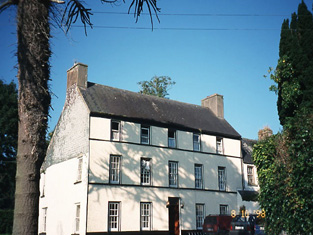
|

